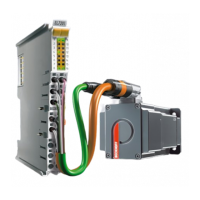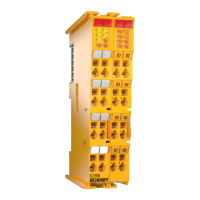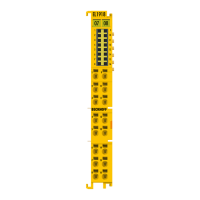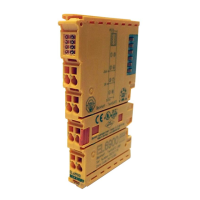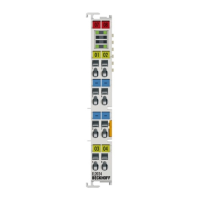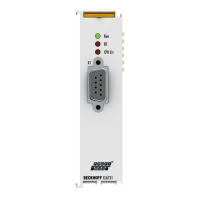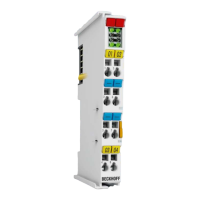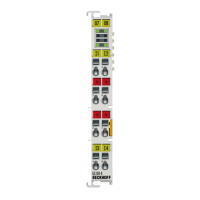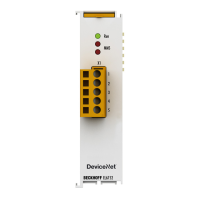Commissioning
EL70x1148 Version: 4.4
0.5% is subtracted from the position determined. If the deceleration ramp has ended and the destination has
not yet been reached, the terminal drives at the velocity “Velocity min.” to the destination. It must be
configured in such a way that the motor is able to stop abruptly and without a step loss at this velocity.
Velocity max.:
The maximum velocity with which the motor drives during a travel command
Note
"Speed range" (index 0x8012:05) [applies to EL70x1]
Velocity min./max. are standardized to the configured "Speed range" (Index 0x8012:05).
This means that for a "Speed range" of 4000 full steps/second, for example, for a speed
output of 100% (i.e. 4000 full steps/second) 10,000 should be entered under "Velocity
max.", and 5,000 for 50% (i.e. 2000 full steps/second).
Acceleration pos.:
Acceleration time in the positive direction of rotation.
The 5 parameters for acceleration also refer to the set “Speed range” and are given in ms. With a setting of
1000, the terminal accelerates the motor from 0 to 100% in 1000 ms. At a speed of 50% the acceleration
time is linearly reduced to half accordingly.
Acceleration neg.:
Acceleration time in the negative direction of rotation.
Deceleration pos.:
Deceleration time in the positive direction of rotation.
Deceleration neg.:
Deceleration time in the negative direction of rotation.
Emergency deceleration:
Emergency deceleration time (both directions of rotation). If “Emergency stop” is set in the appropriate PDO,
the motor is stopped within this time.
Calibration position:
The current counter value is loaded with this value after calibration.
Calibration velocity (towards plc cam):
Velocity with which the motor travels towards the cam during calibration.
Calibration velocity (off plc cam):
Velocity with which the motor travels away from the cam during calibration.
Target window:
Target window of the travel distance control. "In-Target" is set if the motor comes to a stop within this target
window.
In-Target timeout:
"In-Target" is not set if the motor is not within the target window after the expiry of the travel distance control
after this set time. This condition can be recognized only by checking the falling edge of “Busy”.
Dead time compensation:
Compensation of the internal propagation delays. This parameter does not have to be changed with
standard applications.
Modulo factor:
The “Modulo factor” is referred to for the calculation of the target position and the direction of rotation in the
modulo operating modes. It refers to the controlled system.
Modulo tolerance window:
Tolerance window for the determination of the start condition of the modulo operating modes.
POS Features:
Start type:
The "Start type" specifies the type of calculation used to determine the target position (see below).
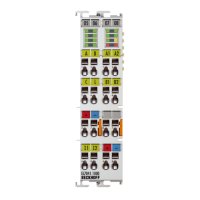
